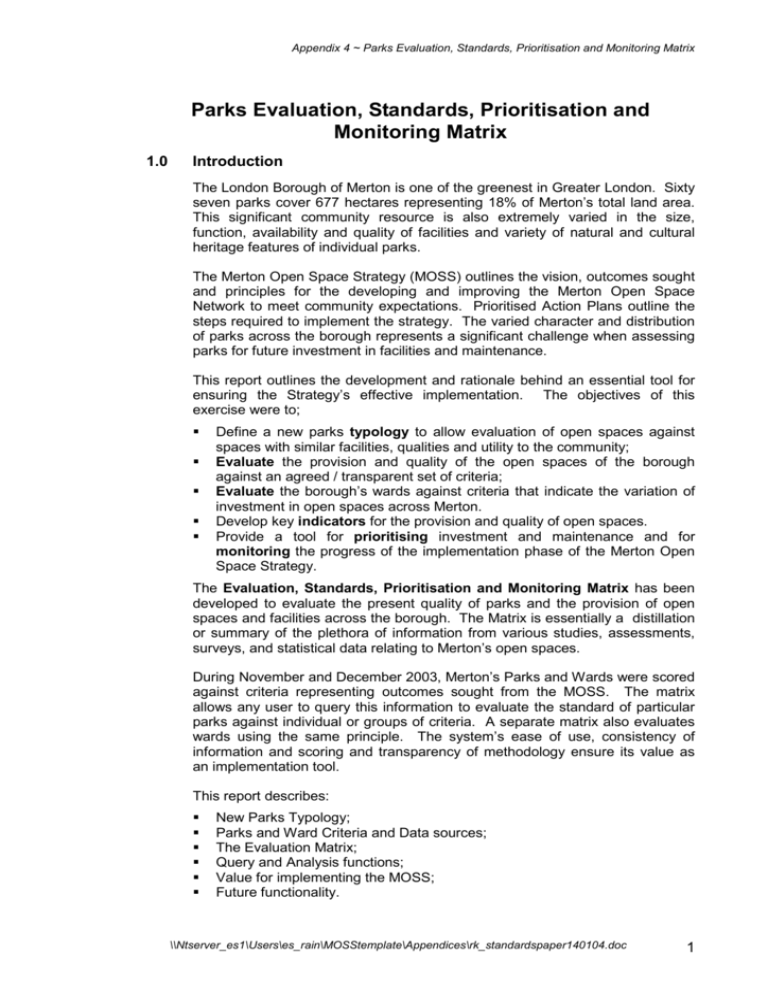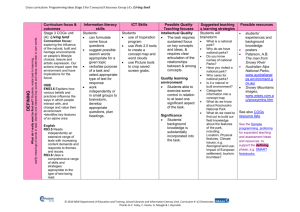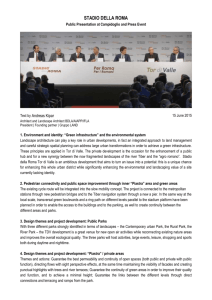Parks Evaluation, Standards, Prioritisation and Monitoring Matrix
advertisement

Appendix 4 ~ Parks Evaluation, Standards, Prioritisation and Monitoring Matrix Parks Evaluation, Standards, Prioritisation and Monitoring Matrix 1.0 Introduction The London Borough of Merton is one of the greenest in Greater London. Sixty seven parks cover 677 hectares representing 18% of Merton’s total land area. This significant community resource is also extremely varied in the size, function, availability and quality of facilities and variety of natural and cultural heritage features of individual parks. The Merton Open Space Strategy (MOSS) outlines the vision, outcomes sought and principles for the developing and improving the Merton Open Space Network to meet community expectations. Prioritised Action Plans outline the steps required to implement the strategy. The varied character and distribution of parks across the borough represents a significant challenge when assessing parks for future investment in facilities and maintenance. This report outlines the development and rationale behind an essential tool for ensuring the Strategy’s effective implementation. The objectives of this exercise were to; § § § § § Define a new parks typology to allow evaluation of open spaces against spaces with similar facilities, qualities and utility to the community; Evaluate the provision and quality of the open spaces of the borough against an agreed / transparent set of criteria; Evaluate the borough’s wards against criteria that indicate the variation of investment in open spaces across Merton. Develop key indicators for the provision and quality of open spaces. Provide a tool for prioritising investment and maintenance and for monitoring the progress of the implementation phase of the Merton Open Space Strategy. The Evaluation, Standards, Prioritisation and Monitoring Matrix has been developed to evaluate the present quality of parks and the provision of open spaces and facilities across the borough. The Matrix is essentially a distillation or summary of the plethora of information from various studies, assessments, surveys, and statistical data relating to Merton’s open spaces. During November and December 2003, Merton’s Parks and Wards were scored against criteria representing outcomes sought from the MOSS. The matrix allows any user to query this information to evaluate the standard of particular parks against individual or groups of criteria. A separate matrix also evaluates wards using the same principle. The system’s ease of use, consistency of information and scoring and transparency of methodology ensure its value as an implementation tool. This report describes: § § § § § § New Parks Typology; Parks and Ward Criteria and Data sources; The Evaluation Matrix; Query and Analysis functions; Value for implementing the MOSS; Future functionality. \\Ntserver_es1\Users\es_rain\MOSStemplate\Appendices\rk_standardspaper140104.doc 1 Appendix 4 ~ Parks Evaluation, Standards, Prioritisation and Monitoring Matrix 2.0 New Open Space Typology It was recognised early in the MOSS development process that the existing open space hierarchy (Metropolitan Park, District Park, Local Park and Small Local Park) was not appropriate for evaluating and monitoring the current standard of open space provision in the Borough. Given the diversity of parks within each of the existing categories, a refined open space typology was needed to accurately reflect the different function of parks. Table 2.1 below outlines the proposed new Merton Open Space Typology and the characteristics of each type of park. The new typology ensures that parks are evaluated against parks with a similar size, range of facilities and natural and cultural heritage features when prioritising investment or monitoring strategy implementation. Table 2.1 New Merton Open Space Typology Parks Type Metropolitan Park Area 60ha District Park 20-60ha Local Sports Facility 2-20ha Local Multi Use 2 -20ha Local Passive Recreation 2 -20ha Nature conservation, landscaping, sitting out areas etc Local Open Space 2 -20ha Small Multi-use Less than 2ha Less than 2ha Less than 2ha Less than 2ha Informal grassland and paths providing opportunities for informal activities Provision for pitch sports, court sports, children’s play, sitting out areas. nature conservation Small Passive Recreation Small Children’s Play Small Informal Open Space 2 Characteristics Either: i. natural heathland, downland, commons, woodland, or ii. formal park providing for both active and passive recreation. May contain playing fields, but at least 40ha for other pursuits. Adequate parking. Landscape setting with a variety of natural features and a range of facilities including outdoor sports facilities and playing fields, children’s play for different age groups and informal recreation pursuits. Some car parking. Accessible by foot, cycle, car and public transport Provision for pitch and court sports. Playing fields and pavilions Accessible by foot, cycle, car and public transport. Limited car parking Provision for pitch sports, court sports, children’s play, sitting out areas, landscaped environment, nature conservation. Nature conservation, landscaping, sitting out areas etc Provides children’s play areas and informal grassland Informal grassland and paths providing opportunities for informal activities Appendix 4 ~ Parks Evaluation, Standards, Prioritisation and Monitoring Matrix 3.0 Evaluation Criteria Development of the Evaluation Matrix is a significant step toward integrating diverse parks information sources. By applying information from the Merton Open Space Study (Volumes 1-3) and Playing Pitch Quality Assessments (see Appendix 1) and other sources such as census and deprivation statistics, individual parks are evaluated against weighted criteria and given an overall score. Wards are evaluated against different criteria and given a score. The new standards evaluation process highlights ’Areas of Deficiency’ to assist in the identification and prioritisation of Action Plan projects. Given that the data sets that the evaluation is based upon are robust and complete this evaluation will provide a useful benchmark for monitoring the strategy. 3.1 Existing Assessment Criteria There are a number of existing standards that provide a useful starting point for the development of the Evaluation Matrix. The table below outlines these standards. The final column indicates whether they are Open Space or Ward standards. Table 3.1: Existing Parks Assessment Criteria Standard Explanation NPFA Open Space Standard Requires 2.43 ha per 1000 population, borough wide we meet this but some areas when compared to this standard are very under provided for (see tab 4.3 in MOSS Volume 1) Pedestrian catchment all areas to be 400m from public open space 280m (where barriers exist), all areas to be 1.2 km from a District or Metropolitan park All areas to be 3.5 km and 5.2 km from District and Metropolitan Parks (this standard is met throughout the Borough). Access to play areas 800m from every home. LEU handbook identifies deficiency areas where there are no notified sites of metropolitan or Borough Importance accessible within 1km. MOSS Volume 3 Identified areas that are beyond 1km from an LNR. However may of these areas are served by other sites of nature conservation importance. Open Space Deficiency Access by Car Playground Access Nature Conservation Access. \\Ntserver_es1\Users\es_rain\MOSStemplate\Appendices\rk_standardspaper140104.doc OS or Ward Ward Ward Ward Ward Ward 3 Appendix 4 ~ Parks Evaluation, Standards, Prioritisation and Monitoring Matrix 3.2 New Parks Evaluation Criteria The aim of the evaluation is to investigate the standard of a variety of open space and ward attributes ultimately ranking each park and ward according to the quality and equality of open space investment across the Borough. Open spaces are assessed against the facilities and experiences they provide the community rather than simply their size and location. The table below provides an explanation of the new Criteria. It sets out the standard being measured, their relevant MOSS outcome areas, scoring and the weighting that was applied in the evaluation. Table 3.2. Standard Accessibility Parks Assessment Criteria Scoring Weight Variable 1 Connectivity 1 Quantity 1 Quality 1 Disabled 1 Signage All open spaces evaluated in this matrix are accessible to the general public through either open access or arrangements with the private owner. Accessibility is a key determinant in the use and enjoyment of the parks. (Data source: MOSS Survey) Area Environment Variable 1= less than 1 ha Regeneration 2= 1 to 2 ha 3= 2 to 10 ha 4= 10 to 50 ha 5= greater than 50 ha The size of a park indicates future potential for increasing facilities . A large park can potentially support more facilities than a small one. Community Community 5 = Friends group Variable Education An existing community group involved in an open space is an important consideration when assessing the standard of a park. The vision and outcomes of the strategy encourage more community involvement in the planning, design and management of open space. Heritage / Heritage and Variable 1 Cultural events Uniqueness culture 1 Open Space within conservation area 1 Listed Landscape 1 Listed Building within Not all of the parks in the Merton open space network have a distinct natural historic, cultural, or heritage features. However, all parks are unique in their own way. This standard aims to identify those areas that contribute specifically to the historical and cultural identity of the Borough (Various Data sources including MOSS Survey) Amenity Access Is it visible from parts of the Variable Regeneration surrounding area? Environment Is it visually attractive? Does it have a clearly definable townscape value? Does it provide relief from the built up area? Is there potential for enhancement and would this contribute to the regeneration of the area? Parks provide relief from built up areas and the provision (1 point for each). (Data Source: MOSS Survey) 4 Outcome Accessibility Equity Appendix 4 ~ Parks Evaluation, Standards, Prioritisation and Monitoring Matrix Nature Conservation Environment Education Heritage 1= LEU local importance, or LNR Variable (LNR only) 2= LEU Borough importance (Grade 2) 3= LEU Borough Importance (Grade 1) 4= LEU Metropolitan Importance 5 = SSSI : Does any part of the open space have a significant ecological value? (Data Source: Q.16 MOSS Survey) Overall Quality All outcomes Variable 1 = poor 3 = fair 5 = good Assesses the condition of built structures, railings, drives and paths, rubbish bins, seats and the overall condition of the park. (Q27 of the MOSS Survey) Pavilion Variable Community 1 = very poor (<30%) Education 2 = poor (30-39%) Healthy lifestyle 3 = average (40-59%) 4 = good (60-89%) 5 = excellent (>90%) An important community resource and an asset for sports clubs. A pavilion on site provides more potential for development of partnerships with the local community or sports teams. (Data Source: Sport England Pavilion quality assessments) Pitch Quality Healthy lifestyle 1 = poor (<30%) Variable Equity 2 = below average (30-54%) 3 = average (55-64%) 4 = good (64-90%) 5 = excellent (>90%) The quality of pitches was evaluated through the Sports England Quality Assessments. The assessments included: Quality of playing surface, problems with dogs, litter, damage and unofficial use. Range of Facilities All outcomes Variable Nature = 0.25 each Sports 0 = 0, 1-14 = 0.5, 15+ = 1 Children 0.25 each Informal use 0=0, 1-4 = 0.25, >5 = 0.5, 10+ = 1 Ancillary Facilities (e.g. toilets) 0=0, 1-3 = 0.25, 4-6 = 0.5, 7-10 = 0.75, 11= 1. The greater the range of facilities on a particular site the more valuable the open space to its adjacent community. Facilities with a wide range of facilities are usually popular with the wider borough community. A score is allocated for each of the categories including: nature conservation, sports provisions, facilities for children, other attractions and premier attractions. (Data Source: MOSS Survey). Safety and Variable Environment 1 = threatening Security Regeneration 2 = unsettling Healthy 3 = safe Lifestyle 4 = comfortable A major factor in a visitors perception of a park. (Data Source: Q33 MOSS Survey) Community Variable 1 = both Vandalism 3 = vandalism or graffiti Environment 5 = no Are graffiti and vandalism obvious problems? Graffiti and vandalism significantly reduce peoples enjoyment and use of a park. (Data Source: MOSS Survey) Floodplain Environment Variable 0 = no 5 = yes \\Ntserver_es1\Users\es_rain\MOSStemplate\Appendices\rk_standardspaper140104.doc 5 Appendix 4 ~ Parks Evaluation, Standards, Prioritisation and Monitoring Matrix Does the park provide flood mitigation? A key intrinsic feature of a park. (Data Source: Environment Agency, Floodplain Maps) 3.3 The Ward Evaluation Criteria The following are criteria developed to compare open space provision and quality across the wards of Merton. The criteria examine the amount of open space and specific facilities available to ward residents, the socio economic status, and the accessibility of spaces. The table below details the criteria, outcome area, scoring and weighting for the final analysis. Table 3.3 Ward Assessment Criteria Standard Range of Facilities Score Weight 5 1= 0.1 to 2 (total) 2= 2 to 4 3= 4 to 6 4= 6 to 8 5= 8+ This standard examines the range of facilities in the open spaces across the ward. This score will reflect areas where specific facilities are lacking. Sum of range of facilities scores for all the parks in a ward (Use tab 5.5 in MOSS). Population per Equity 1 1= no open space hectare of open Accessibility 2= 0.1 to 1ha per 1000 pop.n space 3= 1.1 to 2ha per 1000 pop.n 4= 2.1 to 3ha per 1000 pop.n 5= over 3ha per 1000 pop.n NPFA standard for open space per 1000 people is 2.43 ha. The pressure on open spaces in a ward, especially smaller local parks, is linked to population pressure from the adjacent resident population. (Data Source: Tab 4.3 MOSS) Deprivation 1= 28+ Equity 5 2= 21 to 28 3= 14 to 21 4= 7 to 14 5= 0 to 7 The deprivation score is derived from Indices of Deprivation 2000 (Multiple Deprivation Index) Accessibility 1= 0.1 to 2 Accessibility 4 Equity 2= 2 to 4 Q22-26b 3= 5 to 9 4= 9 to 15 5= 15+ Sum of accessibility scores for all the parks in a ward. Ethnicity Equity 3 1= over 36% of population nonwhite 2= 28 to 36% 3= 19 to 27% 4= 10 to 18% 5= 1% to 9% The Needs survey found that people from ethnic minorities were less likely to use open space than the white population. Those wards with a high proportion of ethnic minorities will require action to increase ethnic minority use (Data Source: 1991 census) 6 Outcome Area All outcomes Appendix 4 ~ Parks Evaluation, Standards, Prioritisation and Monitoring Matrix Pedestrian catchment Accessibility 1= Large POS deficiency & Large District Park deficiency, or Large POS deficiency & medium District Park deficiency. 2= Medium POS deficiency & Large District Park deficiency. 3= Small POS deficiency & Medium District Park deficiency, or Medium POS deficiency & Medium District Park deficiency. 4 4= Medium POS deficiency & Small District Park deficiency or Small POS deficiency & Medium District Park deficiency. 5= Small POS deficiency & Small District Park deficiency. The GLA Hierarchy sets out standards of pedestrian access to various types of open space. Those wards that are identified as having deficiencies therefore need investment in open space (Data Source MOSS Vol 1 figure 4.3 and figure 4.4) Children’s Equity Number of children’s play areas 3 facilities Healthy in the ward. Lifestyle Children’s facilities are highly desirable facilities in any ward and they are very popular with females taking children to the park. The standard for provision is related to pedestrian access to these facilities within a ward. Nature Environment 2 1= Large Nat con deficiency & conservation Large LNR deficiency, or Large access Nat Con deficiency & medium LNR deficiency. 2= Medium Nat con deficiency & Large LNR deficiency, or Large Nat Con deficiency & Small LNR deficiency. 3= Medium Nat con deficiency & Medium LNR deficiency, or Small Nat Con deficiency & Large LNR deficiency. 4= Medium Nat con deficiency & Small LNR deficiency, or Small Nat Con deficiency & Medium LNR deficiency. 5= Small POS deficiency & Small District Park deficiency. Those wards that are identified as having deficiencies in open spaces with nature conservation score highly (Data Source MOSS Vol 2 Figure 3.1 and 3.2). N.B West Barnes & Figges Marsh also have a areas that are 1km from Accessible Metropolitan or Borough Importance (LEU Handbook). Health Deprivation Healthy X2 1= 0 to 0.39 Lifestyle 2= -0.4 to 0 3= -0.8 to –0.4 4= -1.2 to –0.8 5= -1.6 to –1.2 Open Space can play an important part in promoting healthy lifestyles, through active and passive recreational activities. Health deprivation in a particular ward is an important consideration for investment in open spaces and their facilities. Wards with a high health deprivation score are a high priority for investment (a score of five denotes a healthy ward – a score of one indicates a less health / more heatlh deprived ward) ( Data Source: Indices of Deprivation 2000, Health Deprivation Score) \\Ntserver_es1\Users\es_rain\MOSStemplate\Appendices\rk_standardspaper140104.doc 7 Appendix 4 ~ Parks Evaluation, Standards, Prioritisation and Monitoring Matrix Community Community Total # of parks friends groups in 2 Potential the ward Community potential is the total of established parks friends groups in the ward. Engaging the community in all aspects of parks planning and management is a key outcome of the strategy. A high score indicates higher existing potential for direct involvement of the community in open spaces. Data Source Leisure Services records. 4.0 Functionality The Evaluation Matrix have been developed using Excel spreadsheets. Parks scores are inputted under each of the criteria and the spreadsheet calculates each park’s score. Weighting for a particular criteria may be applied in the weightings table and the scores immediately reflect the weighting or any combination of weightings. By using different weightings for each criteria its possible to see how a particular park scores against particular factors Examples of this process are set out in Table 4.1 and Charts 1 to 7. Weightings are automatically calculated by typing into a multiplication factor to a table on the Evaluation Matrix. Weightings can range from zero up and can be any combination of numbers. It is intended this function be at the front end of a graphic user interface in a future version of the Evaluation Matrix (see Merton Open Space Strategy section 6.3 Action Plan 6). Figure 4.1 Evaluation Matrix The results can then be displayed graphically in bar charts. Parks are displayed within their typology to allow ease of analysis between similar parks and the entire network. 8 Appendix 4 ~ Parks Evaluation, Standards, Prioritisation and Monitoring Matrix 5.0 Results Analysis of the results followed the input of scores into the standards matrix. The criteria scores were weighted according to the area under investigation. The table below describes the separate queries performed. Table 4.1 Chart # 1 2 3 Parks Assessment Charts Title Weightings Merton Parks Merton Parks ~ Range of facilities Merton Parks ~ Quality Unweighted Range of Facilities. Overall quality *5 Amenity*10 Vandalism*10 Safety*10 Other *1 Accessibility*10 Heritage / Culture *10 Nature conservation *10 Floodplain *5 Pitch Quality *10 Pavilion Quality *10 Range of facilities *5 Community *5 Other *0 Weights in Section 3.3 4 5 Merton Parks ~ Accessibility Merton Parks ~ Intrinsic Value 6 Merton Parks ~ Sports Emphasis 7 Merton Parks ~ Community Potential Merton Parks ~ Ward Assessment Merton Parks ~ Ward Total Scores 8 9 Weightings in Section 3.3 The Matrix makes it possible to perform any number of queries against the dataset. \\Ntserver_es1\Users\es_rain\MOSStemplate\Appendices\rk_standardspaper140104.doc 9 Appendix 4 ~ Parks Evaluation, Standards, Prioritisation and Monitoring Matrix 6.0 Next Steps The integration, and scoring of parks against, criteria developed from the MOSS databases makes the Evaluation Matrix an important tool for: § § § § § Evaluating park standards; Prioritising Investment; Prioritising Maintenance; Setting Performance Indicators and; Monitoring Implementation of the Strategy. Investment in further developing the functionality of the Evaluation Matrix should focus on: § § § § § 10 Building a graphic user interface to ensure ease of use by any member of staff; Integration with place based GIS database to identify spatial trends; Enhance query functions to include statistical analysis, trends over time etc; Develop a data management plan; Develop procedure to update the scoring based on the review of data sources.








